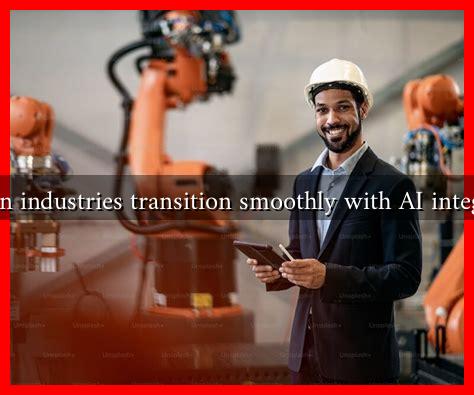-
Table of Contents
How Can Industries Transition Smoothly with AI Integration?
The integration of Artificial Intelligence (AI) into various industries is no longer a futuristic concept; it is a present-day reality. As businesses strive to enhance efficiency, reduce costs, and improve customer experiences, the adoption of AI technologies has become imperative. However, transitioning to AI is not without its challenges. This article explores how industries can navigate this transition smoothly, ensuring that they harness the full potential of AI while minimizing disruption.
Understanding the Importance of AI Integration
AI technologies can significantly transform industries by automating processes, providing insights through data analysis, and enhancing decision-making. According to a report by McKinsey, AI could potentially add $13 trillion to the global economy by 2030. This staggering figure underscores the importance of AI integration for businesses looking to remain competitive.
Key Steps for a Smooth Transition
To ensure a seamless transition to AI, industries should consider the following steps:
- Assess Current Capabilities: Before implementing AI, organizations must evaluate their existing technological infrastructure and workforce capabilities. Understanding current strengths and weaknesses will help identify areas that require improvement.
- Define Clear Objectives: Establishing clear goals for AI integration is crucial. Whether it’s improving customer service, enhancing operational efficiency, or driving innovation, having specific objectives will guide the implementation process.
- Invest in Training and Development: A successful AI transition requires a skilled workforce. Companies should invest in training programs to upskill employees, ensuring they are equipped to work alongside AI technologies.
- Start Small: Implementing AI on a smaller scale allows organizations to test its effectiveness without overwhelming their systems. Pilot projects can provide valuable insights and help refine strategies before a full-scale rollout.
- Foster a Culture of Innovation: Encouraging a culture that embraces change and innovation is essential. Employees should feel empowered to experiment with AI tools and share their experiences, fostering a collaborative environment.
Case Studies: Successful AI Integration
Several industries have successfully integrated AI, serving as models for others looking to make the transition:
- Healthcare: The use of AI in healthcare has revolutionized patient care. For instance, IBM Watson Health has been instrumental in analyzing vast amounts of medical data to assist doctors in diagnosing diseases more accurately and quickly.
- Manufacturing: General Electric (GE) has implemented AI-driven predictive maintenance in its manufacturing processes. By analyzing data from machinery, GE can predict failures before they occur, reducing downtime and maintenance costs.
- Retail: Amazon’s recommendation engine is a prime example of AI integration in retail. By analyzing customer behavior and preferences, Amazon can provide personalized shopping experiences, significantly boosting sales.
Challenges to Consider
While the benefits of AI integration are substantial, industries must also be aware of potential challenges:
- Data Privacy Concerns: The use of AI often involves handling sensitive data. Organizations must ensure compliance with data protection regulations to avoid legal repercussions.
- Resistance to Change: Employees may resist adopting new technologies due to fear of job displacement. Transparent communication about the benefits of AI and how it complements human roles can help mitigate this issue.
- Integration with Legacy Systems: Many organizations still rely on outdated systems that may not be compatible with new AI technologies. A thorough assessment and potential upgrades may be necessary.
Conclusion
The transition to AI integration is a complex but rewarding journey for industries. By assessing current capabilities, defining clear objectives, investing in training, starting small, and fostering a culture of innovation, organizations can navigate this transition smoothly. Successful case studies from healthcare, manufacturing, and retail illustrate the transformative potential of AI. However, it is essential to remain vigilant about challenges such as data privacy, resistance to change, and legacy system integration. By addressing these issues proactively, industries can harness the power of AI to drive growth and innovation.
For further reading on AI integration strategies, you can explore resources from McKinsey & Company.

